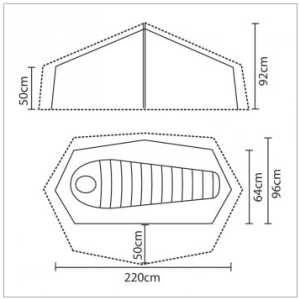Eek. I write a glowing review for a product and almost immediately it fails to live up to my review. Shortly after writing about the Zephyros 1 I discovered a significant failure.
Unable to get a taut pitch as the pole wasn’t curving into a smooth shape, I found a significant bend in one section.

Here I need to stress that the tent hasn’t been pitched in high winds or under extreme duress. However it has always been very hard to get the pole into both outer eyelets on either side of the tent and needs brute strength. The instructions say it’s normal for the pole to take a curve over time so I wrote to Terra Nova customer services to ask if what had happened was normal and if it might potentially rectify itself over time by the rest of the pole taking a similar shape and, if not, what my options were.
Then I waited.
After a week I contacted Terra Nova via Twitter to see if they’d received my email. This bump got me a reply. No, this wasn’t normal and they would replace the pole as a ‘goodwill gesture’ if the tent was still in warranty. This seems odd to me. Surely if the product has failed under warranty it’s not a goodwill gesture to replace it? But whatever. I posted the bent pole off to Terra Nova on the 27th and it was received on the 29th. 4 working days later I received an email saying they’d received it and would get back to me as soon as possible.
A week later and I still haven’t heard anything or received a replacement pole. Now the returns paperwork declares that repairs can take up to 8 weeks but this is just a replacement pole. They’re not actually having to repair anything. If they’re out of stock then I’d expect at least an email to let me know what’s happening.
This isn’t a case of the worst customer service on record but it IS off-putting. Before this I wouldn’t have hesitated in buying or recommending their products but now I’m having doubts. Certainly the Zephyros 1 Lite is off my wish-list for now.
Saga to be continued and I’ll update this blog post as more happens. At least I have another solo backpacking tent I can use this month! Anyone else had any experience, better or worse, with Terra Nova Customer Services? I’d be interested to know if this is normal for them or for tent manufacturers in general or if it’s just a singular occurrence.
Update Monday 16th June.
The day I posted this blog post (11th June) I received an “@” reply from a friend via Twitter that cc’d in Terra Nova. Without being asked directly, the next day (12th) the person managing the company’s Twitter account contacted their Customer Services department to chase up the replacement order. Then they came back to me to ask if Customer Services had contacted me. So I have to say, excellent service from Terra Nova’s Twitter account! Timely, proactive, and professional.
The subsequent email I received from Customer Services said “As discussed in our earlier emails although the damage is not covered by our 2 year guarantee” and that a replacement pole would be sent out “asap”. I wasn’t happy with either of these statements so wrote back saying that the cause of the damage hadn’t been discussed, it hadn’t been caused by misuse/neglect/accident, and that “asap” is not a timescale. I also specified that I wasn’t happy with the service I was receiving.
I don’t know if either of the following 2 actions prompted a same day response but I’ll include them here just in case. Firstly I told the person managing Terra Nova’s Twitter account that I’d received a reply from Customer Services but that my issues hadn’t been resolved yet. Secondly I attempted to copy in the Managing Director of Terra Nova, Andy Utting, by guessing his email address.
So the same day I received a response from Terra Nova which I’ll include here…
Thank you for your e-mail. We are sorry you are disappointed with our gesture of goodwill offer.
Unfortunately the guarantee is not against any sort of failure or general degradation of materials. We only make judgments as to whether the particular problem emanates from an original defect in materials or workmanship.
After inspecting your returned pole although we are unable to confirm how, we do conclude in our experience that at some point the pole has been bent at 2 sections due to some kind of external force/duress, this would have been quite strong to bend the sections.
However we have arranged to replace the pole at no cost as a gesture of goodwill.
and the replacement pole should be despatched today, at the latest tomorrow.
We will check this and confirm exactly for you.
If you are concerned about the tent, although we are not aware of a problem with this model you can return the tent to us for full inspection and we could pitch and check the tent in more detail for you.
Following this email I then received a follow up email confirming that the replacement pole had been posted that day! It arrived 2 days later on the Saturday (14th June).
I’ve tested the new pole today, very carefully. Honestly I think the problem is that the pole is too long for the tent, i.e. that the tent has a fault. Undue pressure has to be put on the pole to get it into the eyelets and when pitched it looks like a tauter pitch could be achieved if the pole was bent at a shallower angle.
So I’ve taken it all down and it’s sitting on the table.
I know I should post it back to Terra Nova for them to investigate. If I continue to use it, the replacement pole might be damaged the way the last one was. However, I’m loath to spend more money on this tent. I’ve already paid for postage and packaging back to Terra Nova once. Alternatively I could try and fix it myself by somehow, perhaps by lengthening the tape that runs between the eyelets underneath the tent.
Honestly at this point I just want shot of the thing. It’s really hit home how important confidence is with tents. I’m due to go backpacking soon and this is the tent I would usually take but now I’m concerned it may fail.
One last thing. I’ve had a few people tell me their Terra Nova Customer Services stories. One person said he’s had nothing but good service. However three people told me at length of their experiences and how they wouldn’t buy another tent from Terra Nova because of how poor the aftercare was. One friend saying that he’d had excellent service from Hilleburg which is why he’s now their loyal customer.
Thanks for following my Terra nova Customer Services saga. If you’d like to share your experiences with them or any other manufacturers or have any comments please share them below.
















































